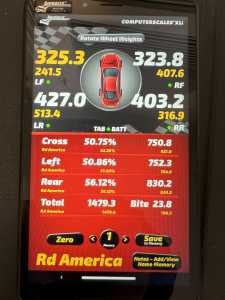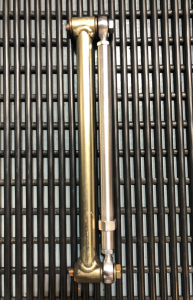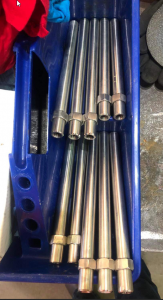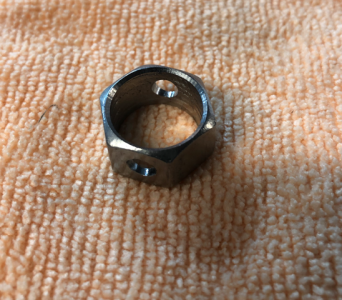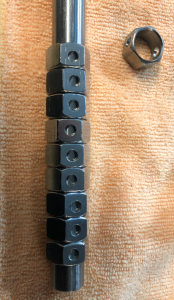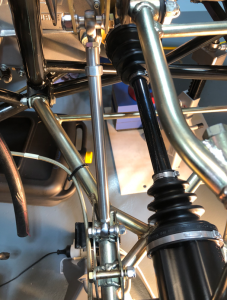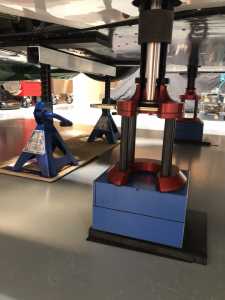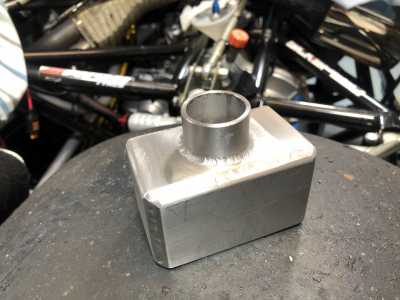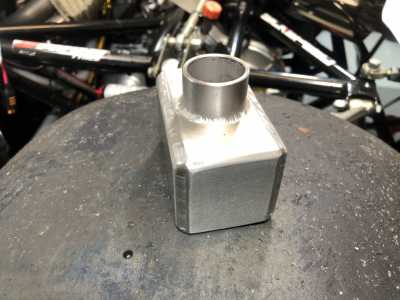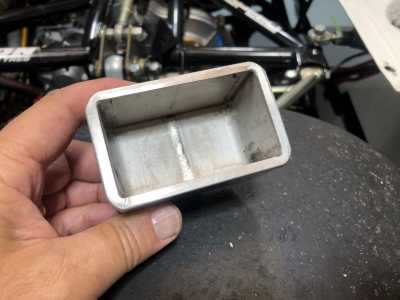
Posted by: @schnellerJust so I am completely clear: You are completely off the brake after turn in?
Yes, for a typical turn in, I stand on the brakes initially, and then I am coming off of the brakes as the brake zone ends, still holding some amount of trail brake as I turn in, and then completely off the brakes after turn in. It is a progression of very hard braking deep into the brake zone, immediately followed by a gradual release of the brakes. If I brake too deep and hold too much brake after turn in then the car will spin or I will have to catch it by getting off the brakes quickly and counter steer to prevent a spin.
Posted by: @schnellerI appreciate the info. Previously I was driving a GT3 with traction control and ABS. The Radical has been a learning eperience in chassis weight balance for me!
If you are lucky, it just requires more track time to get used to this car. It could be anything, or a combination of things. My suggestion is to ensure that the car is setup to the factory spec, and then drive it a lot. Also, make sure you adjust your bias so that you can threshold brake without locking the rear tires -- it is something that takes a few seconds to adjust and makes a huge difference. If your bias is too much on the rear brakes, then light trail braking could cause the rears to lock and then you loose rear traction while turning, causing oversteer. I dial in a lot of front bias.
@davidf David, running more front bias is something I'm going to try this year. I've been running 54%, but I think I'll try something close to 60%. Any thoughts? 🤔
Hi John. I have to look at my data for the percentage, but 60% sounds familiar. Sitting in the car, you can set your initial bias, but generally you want tune the bias on the track so that the fronts and rears to lock simultaneously -- for threshold braking. To set this adjustment, you need to purposely go over the threshold for a very brief moment (avoiding flat-spotting the tires) to determine whether fronts or rears lock up first. In a race, I use the pace lap to adjust the bias, and as needed throughout the race. On a practice session, once the brakes and tires warm up, I will wait until no one is behind me to set the bias.
A couple years ago my driving coach Russ McDonough was telling me to fix my brake shape in the brake zone of turn 5 at Barber. What he meant was to hit the brakes really hard initially, and then smoothly come off the brakes so that I had just a little bit of trail at turn-in. I could not execute it because it is a downhill brake zone and I did not have enough forward bias, causing my rear tires to lock every time I hit the brakes hard. So I was compensating by braking much earlier and lighter throughout the brake zone. If you look at the data, a good brake pressure "shape" is straight up to peak pressure, followed immediatley by a straight gradual release of the brake. So the shape looks like a sawtooth -- straight up followed by a straight diagonal line down. If you don't have your bias set optimally, your brake shape, and thus braking suffers.
Another coach, Franklin Futrelle, who can outbrake just about anyone says to imagine that a dog has run out in front of your car when braking. In other words, brake way harder initially, and that will move your braking zone forward.
I will be at Winterfest with Group-A Racing. We should meet and chat. I think I will be on the track with you on Thursday.
@davidf Thanks very much for all that info. I think I've got a decent brake shape, but my goals this year are to add more trail-braking and to move my brake points deeper. I've always felt just a bit uncomfortable at turns 7, 10, and 13 at Sebring as the rear wants to move under initial braking. Switching to a Hewland gearbox (and away from the torque-biased Quaife differential) made a difference, but I think there is more there from more front bias.
I'll be at Winterfest on Wednesday (coming in Tuesday afternoon, leaving Wednesday evening). I hope to see you there.
John
Posted by: @schnellerIf I unscrew the small screw on the shock collar does that unlock it and allow it to turn to add preload to the shock? Also if I turn it one revolution clockwise how many pounds does that transfer to the opposite front wheel?
i have discovered that my left front wheel is 100 lbs lighter than the right front wheel after doing corner balancing. So I am adding preliad to the right rear shock.
I did a ride height reset and complete setup yesterday. Mine was off by 166/196 pounds in the front/rear corners. I split the adjustment evenly between all four pushrods, never touching the damper springs during corner balancing. The rake and overall ride height was within 1/2mm from where I set it before corner balance. The front left and right drop heights were different by 1/2mm, and the rears 1mm after corner balancing. It took 3 or 4 turns on each pushrod to achieve balance.
@bird - Hi Jay, Radical wanted around AU$700 per set.... So we made our own from some 5/8" diameter (or 16mm) 316L stainless steel bar, and purchased the Chrome-Moly heim joints from a local race parts supplier. I already had a set of right hand 3/8" UNF taps, so we just purchased a set of left hand 3/8" UNF taps to thread the opposite end of each pushrod.
The factory supplied pushrods have a set of flats machined into them to allow you to out a 13mm wrench on them to aid adjustments. We didn't do that and instead got some stainless steel nuts that were 19mm across their flats (or 3/4"), and ran a 5/8" drill through these removing the thread, then through drilled them to allow them to be plug welded onto the outside of the 5/8" stainless pushrods. These work great! We chose to put the nut on the end of the pushrod that had the right hand thread so that we would more easily remember which end had the left hand thread.
We were making sets for an older SR3, my RSX as well as spares for my newer XX... and interestingly they were all a bit different in length (although the XX and RSX were almost the same as you would expect)
From what I have written down here in my workshop - it looks like the approximate lengths for the RSX were 230mm between heim joint centres on the front pushrods, and 280mm on the rear pushrods. Making allowances for the heim joints (17.5mm each), the exposed thread needed to allow adjustment (made an allowance of 5mm each end), and the lock nuts (6mm thick) - that meant that the bar stock was machines to a length of 180mm for the fronts and 230mm for the rears. Please recheck these for your car before assuming they are correct!
Here's some photos that might help.
Old rear RSX link with new adjustable pushrod - setting length the same to help get a good starting point for the new set-up
Here's what we made
Here's the idea to use a nut to make adjustments easier... worked great
Finished and installed
Hope that helps
@rjbender WOW!! I have a buddy who is a fabricator that I have raced with for many years. He truly builds some of the prettiest and perfectly engineered stuff. I have never seen anybody come close to his quality until seeing your work! They are engineered perfectly, designed to be usable, and you even lightened the nuts with the holes. Incredible work Rod. We will be making some for sure. Would there be any issues with these parts being used on your car if you raced in a radical cup race?
Finally, I have not had the opportunity to do any kind of chassis set up on a double wishbone car. My experience has been NASCAR late models, Legend race cars, and dirt midgets, and dragsters. I have been Google searching nonstop trying to find set up videos/discussions for a radical race car. No luck. If you know of any, please post a link here if possible. Thank you Rod.
@bird The best setup videos I've found are from HP Academy: Suspension and Car Setup | High Performance Academy (hpacademy.com) They cost money, but I find them worthwhile.
@rjbender Hey Rod, I just noticed after enlarging the picture of the adjustable rod that it looks like you have an adapter on your jack stand for the car. Am I correct? If so, can you post the specs of that item as well.
Jay
@bird ... Hi Jay, Yes, that's something I made very early after buying my Radical and getting it up on my jack stands for the first time. I wanted a 'fail-safe' support under the car to allow me to afely work underneath. I use two jack stands at the front of the chassis which sit inside an aluminium channel with foam strip on top - this sits across under the chassis where there is a cross member (just behind the footwell). Here's a photo of that...
The thing you are referring to is the solution for the rear end.
Here's some photos - I haven't kept the dimensions, but you'll need to make it fit the 'head' of your jack stand anyways and they are all slightly different.
It's made up from tow short pieces of stainless angle iron that are welded together (that's the weld you can see underneath), with two rectangular 'end-caps' welded in to make a box section. This fits fairly snug over the head of the jack-stand.... then I just welded a piece of tube I found on top... this is where the rear jack-point on the car sits into. The depth of this tube should be at least 1.5 times the increment of your jack-stand ratchet mechanism... that way you can always be sure that it adequately locates the support under the jack-point.
To be clear, while I could allow the care to rest on these, I don't. They are simply raised up to the ratchet point just below the level of that the car is sitting, in case the other air jack supports I have ever failed...
Rod
Posted by: @parsonsj@davidf David, running more front bias is something I'm going to try this year. I've been running 54%, but I think I'll try something close to 60%. Any thoughts? 🤔
At Sebring I checked my bias after a dry race; I was at 63%. In another race which began with a very light rain that resulted in a little less grip than dry, I started with a bias of 60%, and I had to adjust toward the rear about four full turns during the pace lap to prevent my fronts from locking. As the track began to dry, I gradually added more front bias to prevent rear wheels from locking.
I am usually on fresh tires, less than 5 sessions. If you are on old tires, it is probably different; the only way to tell is to brake sufficiently hard to determine whether fronts or rears lock up first.
Oh, and I tried 28 psi hot target on the tires, got up to 30 on the rears, which yielded poor grip with higher pressure. I talked to one of the techs from One Motorsport, and he said that the optimal tire pressure will be different for different tracks. Since I was down on grip most of the week, we went down to 26.5 psi hot which provided much better grip. Other drivers on our team were at 24 psi, but different ride-height, springs and camber than my setup. Summary -- just like bias, tire pressure needs to be discovered for a particular track and conditions.
Posted by: @parsonsjI've always felt just a bit uncomfortable at turns 7, 10, and 13 at Sebring as the rear wants to move under initial braking.
So definitely move bias forward. Turn 7 and 10 are full threshold braking, high pressure but 10 a little softer pressure than 7. I am braking at the 3 marker for turn 7. I can go a little deeper, but I often blow the turn. Also depends on track conditions and tires. Turn 10 I think I am just before the second set of markers around 250 feet. Turn 13 is at the 2 marker, usually begins in 5th gear, quickly down to 3rd before turn in. Turn 13 is not full threshold braking. In turn 17 I was braking past the corner worker on the right depending on the conditions. With lots of Hankook rubber on the track and fresh tires, easily past the corner worker end of barrier, otherwise at that station or before. Back to full throttle well before the bridge, maybe 300-400 feet before and rolling 4th gear.
@davidf Wow, thanks very much for all that information, insight, and advice. I’m sorry to missed you this week. Something came up, and I’m in Hawaii for a bit. Do you have specific corner that you use to set bias? I’ve read that the one to use is 7, but I’m wondering if you agree.
Also, do you know what the Radicals typically turned in for lap times? Just wondering if my car and me would have fit in? I usually run around 2:10 with best of a low 2:08.

